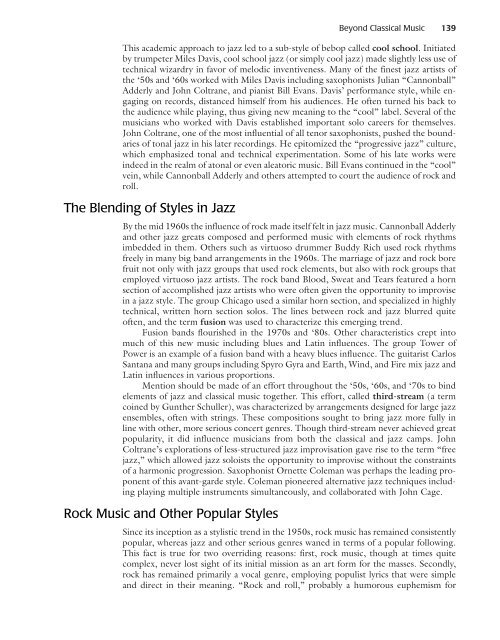Composer Profile - Activefolio
Composer Profile - Activefolio
Composer Profile - Activefolio
You also want an ePaper? Increase the reach of your titles
YUMPU automatically turns print PDFs into web optimized ePapers that Google loves.
Beyond Classical Music 139<br />
This academic approach to jazz led to a sub-style of bebop called cool school. Initiated<br />
by trumpeter Miles Davis, cool school jazz (or simply cool jazz) made slightly less use of<br />
technical wizardry in favor of melodic inventiveness. Many of the finest jazz artists of<br />
the ‘50s and ‘60s worked with Miles Davis including saxophonists Julian “Cannonball”<br />
Adderly and John Coltrane, and pianist Bill Evans. Davis’ performance style, while engaging<br />
on records, distanced himself from his audiences. He often turned his back to<br />
the audience while playing, thus giving new meaning to the “cool” label. Several of the<br />
musicians who worked with Davis established important solo careers for themselves.<br />
John Coltrane, one of the most influential of all tenor saxophonists, pushed the boundaries<br />
of tonal jazz in his later recordings. He epitomized the “progressive jazz” culture,<br />
which emphasized tonal and technical experimentation. Some of his late works were<br />
indeed in the realm of atonal or even aleatoric music. Bill Evans continued in the “cool”<br />
vein, while Cannonball Adderly and others attempted to court the audience of rock and<br />
roll.<br />
The Blending of Styles in Jazz<br />
By the mid 1960s the influence of rock made itself felt in jazz music. Cannonball Adderly<br />
and other jazz greats composed and performed music with elements of rock rhythms<br />
imbedded in them. Others such as virtuoso drummer Buddy Rich used rock rhythms<br />
freely in many big band arrangements in the 1960s. The marriage of jazz and rock bore<br />
fruit not only with jazz groups that used rock elements, but also with rock groups that<br />
employed virtuoso jazz artists. The rock band Blood, Sweat and Tears featured a horn<br />
section of accomplished jazz artists who were often given the opportunity to improvise<br />
in a jazz style. The group Chicago used a similar horn section, and specialized in highly<br />
technical, written horn section solos. The lines between rock and jazz blurred quite<br />
often, and the term fusion was used to characterize this emerging trend.<br />
Fusion bands flourished in the 1970s and ‘80s. Other characteristics crept into<br />
much of this new music including blues and Latin influences. The group Tower of<br />
Power is an example of a fusion band with a heavy blues influence. The guitarist Carlos<br />
Santana and many groups including Spyro Gyra and Earth, Wind, and Fire mix jazz and<br />
Latin influences in various proportions.<br />
Mention should be made of an effort throughout the ‘50s, ‘60s, and ‘70s to bind<br />
elements of jazz and classical music together. This effort, called third-stream (a term<br />
coined by Gunther Schuller), was characterized by arrangements designed for large jazz<br />
ensembles, often with strings. These compositions sought to bring jazz more fully in<br />
line with other, more serious concert genres. Though third-stream never achieved great<br />
popularity, it did influence musicians from both the classical and jazz camps. John<br />
Coltrane’s explorations of less-structured jazz improvisation gave rise to the term “free<br />
jazz,” which allowed jazz soloists the opportunity to improvise without the constraints<br />
of a harmonic progression. Saxophonist Ornette Coleman was perhaps the leading proponent<br />
of this avant-garde style. Coleman pioneered alternative jazz techniques including<br />
playing multiple instruments simultaneously, and collaborated with John Cage.<br />
Rock Music and Other Popular Styles<br />
Since its inception as a stylistic trend in the 1950s, rock music has remained consistently<br />
popular, whereas jazz and other serious genres waned in terms of a popular following.<br />
This fact is true for two overriding reasons: first, rock music, though at times quite<br />
complex, never lost sight of its initial mission as an art form for the masses. Secondly,<br />
rock has remained primarily a vocal genre, employing populist lyrics that were simple<br />
and direct in their meaning. “Rock and roll,” probably a humorous euphemism for



